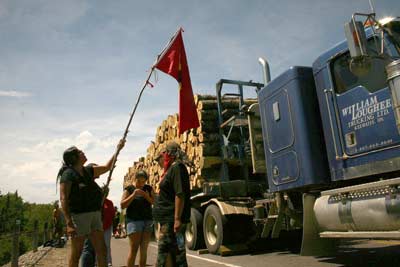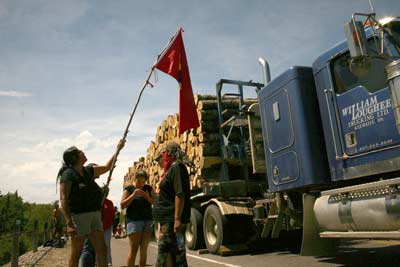
 Grassy Narrows has been working for a decade to end clearcut logging on their Traditional Territory. Activists have erected a 30-foot tall tripod on the highway and perched on top, while others lock themselves to cement filled oil drums, or even the axle of a Weyerhaeuser log truck. (Photo: Rainforest Action Network) (Photo: Rainforest Action Network)The Grassy Narrows’ logging blockade to thwart Canadian government and industry control of their lands is a decade old as the “Idle No More” movement grows.
Grassy Narrows has been working for a decade to end clearcut logging on their Traditional Territory. Activists have erected a 30-foot tall tripod on the highway and perched on top, while others lock themselves to cement filled oil drums, or even the axle of a Weyerhaeuser log truck. (Photo: Rainforest Action Network) (Photo: Rainforest Action Network)The Grassy Narrows’ logging blockade to thwart Canadian government and industry control of their lands is a decade old as the “Idle No More” movement grows.
As natural resources become scarcer worldwide, Canadian Prime Minister Stephen Harper is rushing to sell off the country’s pristine waterways and forests to multinational corporations abroad. As their lands are devastated by industrial projects, First Nations indigenous communities in remote reservations across Canada often suffer most from these efforts. The Canadian economy has long been propelled by resource extraction industries such as mining and logging (with the US being a major trading partner), while plans to build pipelines from the Alberta tar sands to the USA and overseas form the latest battleground.
A glaring example of the government disregard for Aboriginal rights is the passage in December of Bill C-45, which makes unilateral amendments to the Indian Act and changes laws governing waterways and environmental protection. While the Canadian government claims the law is necessary to reduce red tape and protect the economy, it was the last straw for natives who argue the law was illegally passed without their consultation and have reacted by openly calling for indigenous sovereignty and coordinating blockades across Canada.
“They’re not recognizing us as nations,” says Anishinaabe activist Chickadee Richard. “It’s just an act of genocide. I believe they’re trying to extinguish us as nations.” She contends that the environmental impact of this legislation will not just affect indigenous peoples, but all Canadians.
Historically, road and rail blockades have been common last resort tactics employed by First Nations opposing government and corporate actions. Most blockades are temporary, such as the 1990 Kanehsatake blockade in Oka, Quebec, which led to a 78-day standoff with the government (commonly referred to as “The Oka Crisis”) and the more recent Six Nations blockade of a housing development in Caledonia, Ontario, in 2006.
However, the oldest native logging blockade is being held down in a reserve of 900 people called Grassy Narrows. Richard, who lives a couple hours drive from Grassy Narrows in Winnipeg, Manitoba, has been supporting the blockade for the past 10 years. She says the struggle ties back in with the Idle No More movement opposing Bill C-45. “I’ve been travelling from Saskatoon to Ottawa, back and forth, and the underlying message across is to maintain and protect the environments that we as First Nations hold as our traditional territories,” says Richard.
She stresses that like Idle No More, in Grassy Narrows the movement is being led by women. “It’s bringing back that natural law of who we are as matriarchs in society, and it’s happening all across the land.”
This year marks a decade since the community erected the blockade on a logging road at Slant Lake, just outside of Kenora, a small city in northwestern Ontario that relies heavily on forestry.
Since Abitibi began large-scale logging around Grassy Narrows in the ’90s, residents have seen much of their forests destroyed, wildlife habitat disappear, soil depleted and increased mercury levels. Most disturbing, they can no longer fully engage in traditional activities like hunting and trapping, a right enshrined in the treaty signed with the Crown in the 19th century.
In Grassy Narrows, clan mother Judy Da Silva recalls logging always being part of the daily scenery, but when the rate of industrial activity dramatically increased, the community became alarmed. “One day a hunter would go to his hunting grounds, then the next week he’d come and half of it would be gone. Then the next week he’d go and it’s totally gone.”
The Grassy Narrows members’ struggle to thwart government and industry control of their lands is a typical instance of the tenuous relationship between Aboriginals and the government. Grassy Narrows has employed nearly every tactic imaginable, from roving blockades and international boycotts to appeals to the United Nations and dragging the government to court. They have built relationships with international NGOs, media, First Nations communities and grassroots Canadian activists.
Frontline activists like Da Silva have been fighting for environmental justice without rest for years and passing on the torch to their own children to take up the cause. Their people and culture keeps them going, says Da Silva. “The love for our families, the love for our people and the sacred fire, that’s the driving force.”
What follows is an historical retrospective of some of the major events that have led to the longest-standing logging blockade in North America and an area twice the size of Yosemite National Park being protected for the past four years.
1873: Grassy Narrows and surrounding First Nations sign the Treaty 3 agreement, one of the first Post-Confederation Treaties, made with the Crown in the 1870s, across Central and Eastern Canada. While the agreement recognizes native rights to hunt and fish within Treaty 3 region lands, native leaders assert that both federal and provincial levels of government have flouted their responsibility to consult with them on this issue, infringing on treaty rights, to make way for industry expansion on native lands.
1920s: After small-scale logging begins in the area, Grassy Narrows members maintain friendly relations with loggers.
1970s: The government admits that the Wabigoon River is polluted with mercury from the Dryden pulp and paper mill chemical dumping, issuing warnings to locals around Grassy Narrows and White Dog reserves to refrain from fishing. This results in unemployment soaring to 90 percent in Grassy Narrows. Dr. Masazumi Harada, a Japanese expert on mercury poisoning, conducts his first study on the effects of mercury poisoning, Minamata Disease in Grassy Narrows.
1986: Following mounting pressure from Grassy Narrows, the Canadian government and pulp and paper companies commit to a compensation payment for the effects of mercury contamination by signing a Memorandum of Agreement in 1985. The next year, the government creates the Mercury Disability Board in Kenora to administer payments to people affected by Minamata Disease in Ontario. Today, Grassy Narrows residents continue to experience symptoms of mercury poisoning, and the chemical is still present in the soil and waters.
1999: Three Grassy Narrows trappers file for judicial review in response to Mike Harris’ Ontario Progressive Conservative government opening up the Lake of the Woods region to increased logging during the ’90s. This leads to Keewatin v. Ministry of Natural Resources, a decade-long legal case in Ontario Superior Court currently under appeal.
2002: On December 3, two Anishinaabe youth lay down on a logging road at Slant Lake by Grassy Narrows in Lake of the Woods region, an area frequented by tourists looking to camp and fish. More Grassy Narrows members and outside supporters join the action, beginning the 10-year blockade. Grassy Narrows members have built log cabins and wigwams, using the location as a spiritual and cultural site where they hold sacred fires, pow-wows, invite supporters to learn about their struggle and teach their children traditional Anishinaabe practices. Today, Grassy Narrows activists sporadically launch shorter-lived roving blockades along other logging routes in surrounding areas devastated by clear-cut logging.
2004: Grassy Narrows, in collaboration with international NGOs, launches a successful campaign against Weyerhaeuser, a multinational forest products company sourcing wood from traditional lands. Protesters urge boycott and divestment of Weyerhaeuser products and companies buying from Weyerhaeuser. They hold direct actions and banner drops, engage in public education and flyering, buy stocks in the company and storm shareholder meetings. The strategy later leads to Calvert Investments divesting from the company and Sierra Nevada Beer ending business with Weyerhaeuser.
2006: As a result of strong ties to environmental NGOs, a delegation from Rainforest Action Network and Forest Ethics spends the summer in Grassy Narrows, organizing a large gathering at the blockade attended by over 100 supporters from across North America. Activists garner national media attention from a day-long blockade of the Trans-Canada highway. Amnesty International files a briefing to the UN calling for Canada to respect indigenous rights.
2006: The Ontario Superior Court rules the government must pay $2.8 million for Grassy Narrows’ legal costs in the Keewatin v. MNR case. The cost of legal representation is a major obstacle to impoverished First Nations wanting to fight for their rights inside the Canadian court system.
2007: Grassy Narrows declares a moratorium on logging on its lands.
2008: On May 26, Grassy Narrows links up with Ontario First Nations communities fighting industrial actions on their lands, at the Provincial Legislature, holding the first annual “Sovereignty Sleepover.”
2008: Paper and packaging company Boise threatens to stop purchasing from AbitibiBowater if the wood comes from Grassy Narrows territory without First Nations consent. Due to mounting pressure from the blockade, AbitibiBowater, one of the world’s largest logging companies, pulls out of Grassy Narrows.
2010: Paper company Domtar commits to not logging on Grassy Narrows land against residents’ will.
2011: Grassy Narrows declares a major legal victory for First Nations in Canada. After 70 days of hearings, on August 16, Superior Court Justice Mary-Anne Sanderson rules in a 300-page judgment that the Ontario Provincial Government infringed on Grassy Narrows treaty rights when issuing logging licenses in the area.
2011: In the fall, Grassy Narrows activists assert their sovereignty by issuing what they call a “life levy” for cars driving past the blockade. Most hunters and trappers support the gesture.
2012: In March, the court rules that all logging must cease around Grassy Narrows, in the Whiskey Jack Forest north of the English River, pending an appeal by the government in the “Keewatin v. MNR” case. Appeals proceedings begin January 14, 2013.
2012: In June, Grassy Narrows members engage in the third-annual “River Run,” in which activists walk over 1100 miles to Toronto to raise awareness about mercury poisoning, ending in a “Fish Fry” at provincial parliament. Ontario Minister of Aboriginal Affairs Kathleen Wynne responds by visiting Grassy Narrows to set up a committee on mercury contamination.
2012: On December 3, Grassy Narrows celebrates the 10-year anniversary of the blockade by holding events across Canada and the United States.
48 Hours Left: All gifts to Truthout now matched!
From now until the end of the year, all donations to Truthout will be matched dollar for dollar up to $28,000! Thanks to a generous supporter, your one-time gift today will be matched immediately. As well, your monthly donation will be matched for the whole first year, doubling your impact.
We have just 48 hours left to raise $28,000 and receive the full match.
This matching gift comes at a critical time. As Trump attempts to silence dissenting voices and oppositional nonprofits, reader support is our best defense against the right-wing agenda.
Help Truthout confront Trump’s fascism in 2026, and have your donation matched now!